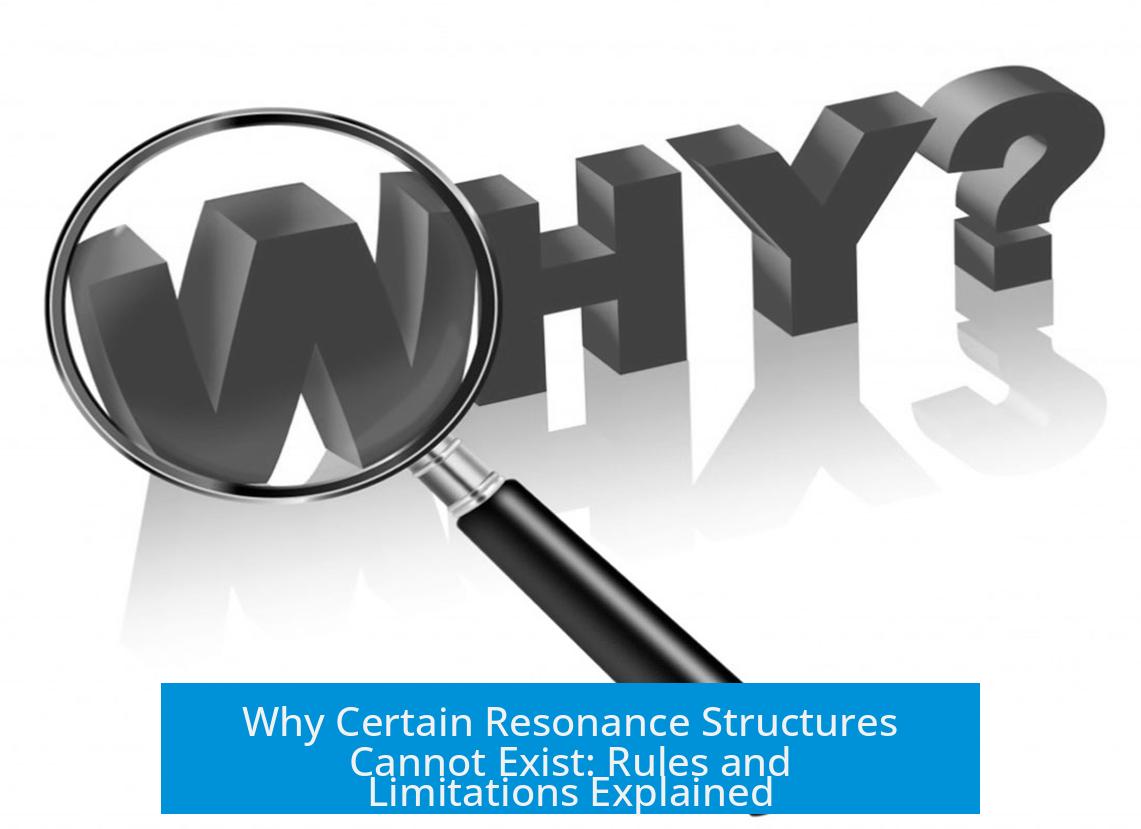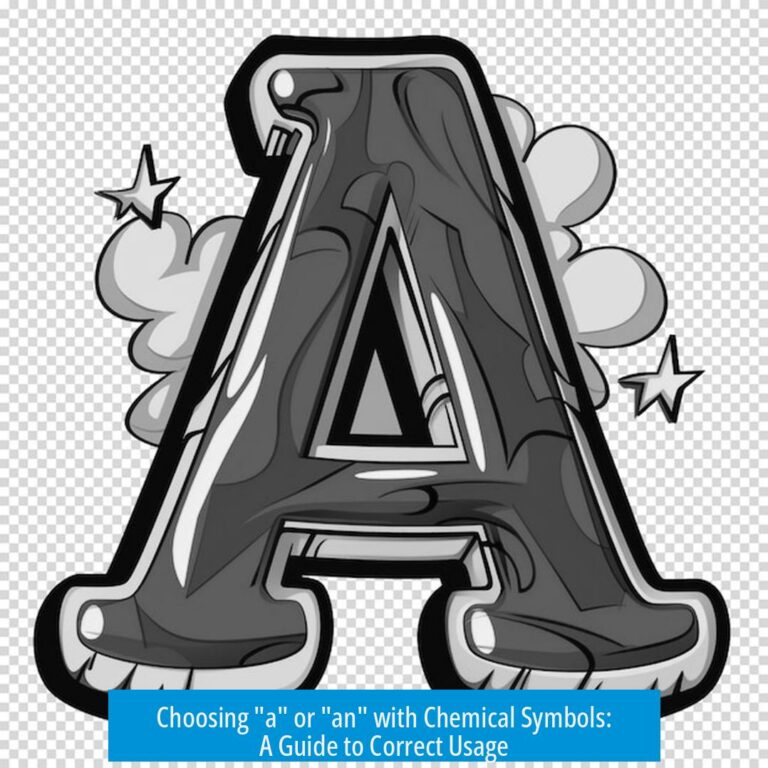Why Does This Resonance Structure Not Exist?

The resonance structure showing a pentavalent carbon does not exist because it violates the octet rule, exceeds carbon’s atomic orbital capacity, misrepresents hybridization possibilities, and breaks fundamental rules for valid resonance structures.
This explanation covers why such a structure is invalid, clarifying atomic, hybridization, and conceptual principles involved. It also discusses the nature of resonance structures and establishes criteria for their validity.
Violation of the Octet Rule
Carbon typically obeys the octet rule, which means it can surround itself with only 8 electrons in its valence shell. This is a fundamental restriction derived from carbon’s electron configuration and bonding capacity.
A pentavalent carbon, pictured with five bonds, would have 10 electrons in its valence shell, surpassing the octet. This is impossible for carbon under normal bonding rules.
- Carbon’s 2s and 2p orbitals hold a maximum of eight electrons.
- Adding a fifth bond violates these electronic capacity limits.
- Thus, any resonance structure depicting a pentavalent carbon is inherently incorrect.
This principle is taught early in organic chemistry and is a key reason why such resonance structures are rejected. Even advanced molecular orbital theory confirms the octet remains a principal constraint for carbon.
Limits of Atomic Orbitals in Carbon

Carbon contains four valence atomic orbitals: one 2s and three 2p orbitals. These orbitals hybridize during bonding but cannot increase in number.
Because there is no accessible fifth valence orbital, carbon cannot form five covalent bonds. This physical constraint on electron organization underpins why pentavalent carbon structures do not exist.
“Because there are no more atomic orbitals on carbon for them to go into.”
Attempting to depict carbon with five bonds ignores these atomic orbital restrictions, making the resonance structure invalid on quantum mechanical grounds.
Hybridization and Conjugation Considerations
Hybridization of atomic orbitals explains bonding and molecular geometry. Carbon typically adopts sp, sp2, or sp3 hybridization.
- sp3 hybridization creates four sigma bonds (tetrahedral geometry).
- sp2 hybridization supports one pi bond alongside sigma bonds (trigonal planar).
- sp hybridization involves two pi bonds (linear geometry).
The concept of sp4 hybridization does not exist since carbon cannot expand beyond four hybrid orbitals.
Additionally, resonance relies on electron delocalization, usually through conjugated pi systems. However, sp3-hybridized carbons do not participate in conjugation because they lack the necessary p orbital overlap for pi bond delocalization.
Therefore, resonance structures requiring pentavalent carbon would imply an impossible hybridization and falsely suggest electron delocalization where none can occur.
Conceptual Clarifications on Resonance Structures

Resonance structures are not real molecules or isomers. They are hypothetical Lewis structures used to approximate the actual electron distribution in a molecule.
Multiple resonance contributors depict possible electron arrangements. The true electronic structure is a hybrid weighted toward the most stable contributors.
- Resonance structures do not interconvert; only the actual hybrid exists.
- Some resonance structures may be minor contributors if they are energetically unfavorable.
- Pentavalent carbon resonance structures are rejected because their energy and electron configuration are not feasible.
Computational chemistry can analyze the stability of various resonance contributors but typically confirms that pentavalent carbon structures are negligible or non-existent.
Requirements for Valid Resonance Structures
Not all Lewis structures are resonance contributors. Specific criteria apply:
- Same molecular formula between all contributors.
- Same number of electrons and net charge.
- Only the positions of pi bonds and lone pairs change.
- Sigma bonds and atomic positions remain fixed.
Structures violating these rules represent different molecules, tautomers, or isomers—not resonance forms.
Examples demonstrate that changing the number of bonds around carbon beyond four creates different molecules, not resonance structures. The pentavalent carbon scenario breaks these conventions.
Summary of Key Points

- **Pentavalent carbon resonance structures violate the octet rule** by placing 10 electrons around carbon instead of 8.
- **Carbon’s atomic orbitals limit bonding to four domains, preventing five bonds.**
- **Hybridization beyond sp3 (such as sp4) does not exist**, making pentavalent carbons impossible.
- **Resonance structures are conceptual, not real molecules, and must follow strict rules.**
- **Valid resonance forms differ only by the movement of pi electrons and lone pairs, with unchanged molecular formula and net charge.**
Additional Notes
Understanding why some resonance structures fail helps students and chemists correctly interpret molecular stability and reactivity. It sharpens awareness of fundamental bonding rules and the limitations of resonance concepts.
Though resonance aids visualization of electron delocalization, it does not permit breaking chemical laws. Recognizing invalid resonance contributors prevents misunderstandings in mechanisms, molecular properties, and spectroscopy.
Why Does This Resonance Structure Not Exist?

The resonance structure showing a pentavalent carbon doesn’t exist because it violates the octet rule, defies the limits of hybridization, and lacks the atomic orbitals necessary to hold five bonds at once. Now, let’s unpack this with some fun chemistry storytelling to keep your brain entertained.
Imagine this: You’re trying to cram five bulky guests (electrons) comfortably around a small circular table (carbon’s valence shell). The table only has eight chairs (electrons) and, spoiler alert, five guests won’t fit without someone sitting on another’s lap. Carbon’s valence shell is just that—limited in space and strict about the number of electrons it can handle.
Carbon’s Octet Rule: The Party Host with Strict Limits
First off, carbon is loyal to the octet rule. It wants exactly eight electrons in its valence shell. That’s four pairs, often arranged as four bonds with other atoms.
Try to make carbon do five bonds, and it becomes a pentavalent beast—a mutant carbon that chemistry teachers love to tease. One medchem teacher even joked that every pentavalent carbon drawn deserves owing him a pint! This is because carbon with 10 valence electrons breaks the octet rule, which is more a guiding principle than a magic law, especially in advanced quantum chemistry.
Simply put, carbon cannot have five bonds. It doesn’t just want to; it physically can’t. That’s because it only has four valence orbitals ready to overlap and share electrons, no more.
Hybridization Limits: Sorry, No sp4 Hybridization Allowed

You might hear someone jokingly suggest sp4 hybridization to squeeze five bonds onto carbon. Here’s the spoiler: sp4 does not exist. Carbon’s hybridization tops out at sp3 when forming four single bonds.
Why does that matter here? Because hybridization dictates which orbitals are used, and how many bonds the carbon can practically form. Since sp4 isn’t a thing, carbon can’t open doors to extra bonding beyond sp3.
Moreover, sp3 hybridized carbons are pretty poor at participating in conjugation—an electron-sharing phenomenon that underlies resonance. Without conjugation, there’s no room for the electrons to shuffle around and create different resonance structures.
Orbital Realities: No Extra Chairs at the Table
Carbon’s valence orbitals aren’t infinite either. It owns one 2s and three 2p orbitals, totaling four. Each orbital forms one bond. Hence, only four bonds maximum.
Trying to force a fifth bond means asking carbon to use a non-existent fifth valence orbital. It’s like expecting someone with four hands to clap five times simultaneously. Nope. Nature says “ouch” to that idea.
Resonance Structures: What Do They Really Represent?
Before we rush to dismiss drawings showing five bonds on carbon, let’s pause to remind ourselves what resonance structures actually are.
Resonance structures are conceptual tools. They’re Lewis structures that chemists use to visualize and understand how electrons might be distributed in a molecule. The actual molecule isn’t flipping between these structures like wardrobe changes; it’s more like a blend or hybrid of the possible electron arrangements.
Because resonance contributors are not real entities themselves, no single resonance structure “exists” in a pure form. Instead, the molecule’s true picture is a blend of valid resonance forms that obey the fundamental rules—like the octet rule and proper hybridization.
So, a resonance structure with pentavalent carbon might appear in a drawing by mistake or as a hypothetical form, but it doesn’t contribute meaningfully to the resonance hybrid. Without computational chemistry to prove otherwise, such a structure is best viewed as an invalid or negligible resonance form.
Requirements for Valid Resonance Structures: The Rules of the Game
- Same molecular formula in all resonance contributors.
- Same number of electrons and identical net charge.
- Same positions of atoms and sigma bonds (only pi bonds and lone pairs can move).
If a proposed resonance structure violates any of these, like changing atom connectivity or breaking the octet rule, it’s not a valid resonance contributor.
Attempting to assign five bonds to carbon not only breaks the octet rule but also tries to rearrange electrons beyond the scope of acceptable resonance moves.
Why Is This Important for You?
When you see a resonance structure with a pentavalent carbon, you should immediately think, “Wait, why is this even here?” Understanding these fundamental limits helps avoid confusion and sets the right foundation for mastering organic chemistry.
Recognizing invalid resonance structures saves time when analyzing reaction mechanisms, predicting molecular stability, or designing drugs in medicinal chemistry. It also keeps you one step ahead when demonstrating your knowledge in exams or lab discussions.
Wrap-Up: The Carbon Conundrum Simplified
In summary:
- Octet rule caps carbon at 8 electrons. Five bonds mean 10 electrons—too many!
- Hybridization limits prevent sp4. Carbon maxes out at sp3.
- Only four valence orbitals exist to hold bonds, so a fifth bond is orbital-less.
- Resonance is conceptual, hybrid, and depends on valid electron rearrangements.
Next time you sketch resonance structures, remember carbon’s limits. Avoid that five-bond fantasy! Instead, focus on valid resonance contributors to truly capture the molecule’s electron dance.
And now, if you ever see a pentavalent carbon in your textbook or notes, just smile and say, “Nice try, but no pint for you!”
Why can’t carbon have five bonds in a resonance structure?
Carbon can only hold 8 electrons in its valence shell. Having five bonds means 10 electrons, which breaks the octet rule. This makes a pentavalent carbon impossible in valid resonance forms.
Does carbon undergo sp4 hybridization to form five bonds?
No. Sp4 hybridization does not exist. Carbon uses sp, sp2, or sp3 hybrid orbitals. Assigning five bonds suggests sp4, which is not physically possible and contradicts known chemistry.
Are resonance structures real molecules that interconvert?
Resonance structures are not actual distinct molecules. They are drawings that help us visualize electron distribution. The real molecule is a hybrid, and individual resonance contributors do not exist on their own.
Can carbon expand its valence shell to accommodate extra bonds?
Carbon has only four valence atomic orbitals. It cannot expand beyond these to form five bonds. This orbital limitation prevents pentavalent carbon resonance structures from existing.
What conditions must resonance structures meet to be valid?
They must have the same molecular formula, electron count, and net charge. Only pi bonds and lone pairs move. Sigma bonds and atomic positions remain unchanged. Violating these rules disqualifies a structure as resonance.





Leave a Comment